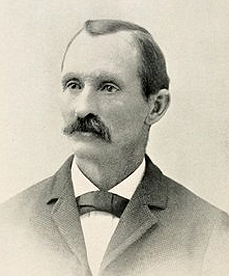Upland was incorporated as a city on May 15, 1906.
At that time it existed as what was perhaps the most significant part of the Greater Ontario area, as it had grown up as a community where the wealthier members of the Ontario business community dwelled in Victorian and early Edwardian homes set amidst citrus groves.
In the early 1880s, Canadians George and William Chaffey were awork establishing irrigation systems that stretched from what is modern-day Ontario out to Etiwanda. Ontario, also known as the Model Colony, was developed as the first residential and commercial center within that area. Ontario incorporated as a municipality in 1891, and its major north-south thoroughfare, Euclid Avenue, extended to what was well north of what was then the Ontario City Limits at G Street. The area north of G Street was at first informally referred to as “North Ontario” or “Magnolia,” a name given it as a consequence of the Magnolia Hotel there. Because Euclid inclined upward toward the foothills below Mount San Antonio as it progressed north, North Ontario/Magnolia were soon referred to as “the upland” and, over time, as Upland.
In 1901, the residents of Upland, highly conscious of the more genteel character of their basically bedroom community compared to the more heavily commercialized Ontario and its earthier and sultrier nature with its concentration of rooming houses, drinking establishments and bordellos, began discussion of incorporating Magnolia as a separate city. Ontario officials moved quickly to stem that, expanding their town’s boundaries, annexing land to become a city of no fewer than 10 square miles.
When Ontario undertook to annex all the way into Magnolia, consisting of the area around modern-day Upland’s downtown, which was to include the Upland Post Office, the tracks for the Atchison, Topeka and Santa Fe Railroad, and the train depot, Magnolia residents moved quickly, appealing to the San Bernardino County Board of Supervisors to arrest Ontario’s hegemonic intent. Beginning on March 12, 1906, the San Bernardino Board of Supervisors conducted a two-day hearing, the upshot of which was that the board agreed to let the voters decide the matter. On May 5, 1906, 202 residents of the Magnolia district of northern Ontario voted on whether to incorporate separately from Ontario, with an overwhelming 183 of those voting to create a new city, San Bernardino County’s fifth, after San Bernardino, Colton, Redlands and Ontario. The City of Upland officially came into existence on May 15, 1906. Continue reading
James Schooler
Rickey Felix
Melinda
William Lindenberg
November 24 SBC Legal Notices
FBN 20230011075
The following entity is doing business primarily in San Bernardino County as
SFI MANUFACTURING, INC. 8570 HICKORY AVENUE RANCHO CUCAMONGA, CA 91739: SOUTH BAY INTERNATIONAL, INC. 8570 HICKORY AVENUE RANCHO CUCAMONGA, CA 91739
The business is conducted by: A CORPORATION registered with the State of California under the number 1843599.
The registrant commenced to transact business under the fictitious business name or names listed above on: N/A.
By signing, I declare that all information in this statement is true and correct. A registrant who declares as true information which he or she knows to be false is guilty of a crime (B&P Code 179130. I am also aware that all information on this statement becomes Public Record upon filing.
s/ TOBY KONETZNY, Chief Executive Officer
Statement filed with the County Clerk of San Bernardino on: 11/01/2023
I hereby certify that this copy is a correct copy of the original statement on file in my office San Bernardino County Clerk By:/Deputy J5842
Notice-This fictitious name statement expires five years from the date it was filed in the office of the county clerk. A new fictitious business name statement must be filed before that time. The filing of this statement does not of itself authorize the use in this state of a fictitious business name in violation of the rights of another under federal, state, or common law (see Section 14400 et seq., Business and Professions Code).
Published in the San Bernardino County Sentinel on November 3, 10, 17 & 24, 2023.
FBN 20230010925
The following entity is doing business primarily in San Bernardino County as
GERBERA DAISY DESIGN 1411 INNISBROOK CIR Upland, CA 91784: SHARI HOLSTEAD 1411 INNISBROOK CIR Upland, CA 91784
The business is conducted by: AN INDIVIDUAL.
The registrant commenced to transact business under the fictitious business name or names listed above on: N/A.
By signing, I declare that all information in this statement is true and correct. A registrant who declares as true information which he or she knows to be false is guilty of a crime (B&P Code 179130. I am also aware that all information on this statement becomes Public Record upon filing.
s/ SHARI HOLSTEAD
Statement filed with the County Clerk of San Bernardino on: 10/30/2023
I hereby certify that this copy is a correct copy of the original statement on file in my office San Bernardino County Clerk By:/Deputy J5842
Notice-This fictitious name statement expires five years from the date it was filed in the office of the county clerk. A new fictitious business name statement must be filed before that time. The filing of this statement does not of itself authorize the use in this state of a fictitious business name in violation of the rights of another under federal, state, or common law (see Section 14400 et seq., Business and Professions Code).
Published in the San Bernardino County Sentinel on November 3, 10, 17 & 24, 2023.
Read The Sentinel!
City Of Chino On The Brink Of Bankruptcy, Municipal Officials Acknowledge
The City of Chino is teetering over a financial abyss so deep and dark, city officials say, that if any of them loses his or her footing, the corpse would never be recovered.
Despite the consideration that Chino has “historically maintained a healthy general fund reserve with the goal of maintaining adequate reserve levels to mitigate future risks,” according to City Manager Linda Reich, “over the last several years spending on the delivery of services and inflation has created annual deficits offset only by appropriations from those reserves.” Thus, according to Reich, “[I]t is anticipated that expenditures will outpace revenues yearly for the next 10-year period and beyond.”
As a consequence, according to Reich, “projected severe deficits in future city budgets” have thrown the city into financial distress. She said, “Revenue increases are being absorbed by the escalating operational costs of services, materials, and labor, and increased inflation, which impact the city’s ability to provide essential services to the community. Operational costs will ‘crowd out’ capital investments and other strategic opportunities.”
Accordingly, Reich has placed before the Chino City Council an item on the agenda for its November 21 meeting calling for the city to officially declare “a fiscal state of emergency.”
Big Bear Contemplating Ending Its Affiliation With Community Fire Service Collective
Twelve years after the City of Big Bear Lake formed a public agency relationship with the larger unincorporated Big Bear community that surrounds it to establish a collective to operate a fire department, its elected governmental leadership is giving serious consideration to opting out of that partnership.
Historically, the Big Bear community and its environs have utilized the services of no fewer than five separate fire agencies. The Big Bear City Fire Department and the Big Bear Lake Fire Protection District, i.e., the municipal fire department which came into existence with the incorporation of the City of Big Bear Lake in 1980, were the two largest entities within the local area among those five.
The 38.45-square mile Big Bear community is home to 17,784 residents. There is some confusion, however about jurisdictional issues in Big Bear, as it consists of two entities, the City of Big Bear Lake and Big Bear City. Despite its name, Big Bear City is not a municipality but rather an unincorporated county area and a designated census place. Big Bear Lake is an incorporated municipality. Despite its status as an actual city, Big Bear Lake is smaller than Big Bear City both in terms of land area and population. Big Bear Lake is 6.42 square miles and has 5,046 inhabitants. Big Bear City is an expansive 32.03 square miles with 12,738 residents. While both qualify as rustic mountain districts, the more compact Big Bear Lake is slightly more urbanized and densely populated. The Big Bear City Community Services District oversees the delivery of water, sewer service and trash service to the unincorporated county area of Big Bear City. It is overseen by an elected board of directors. Continue reading





